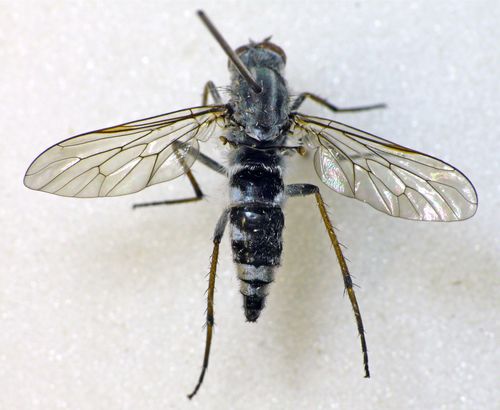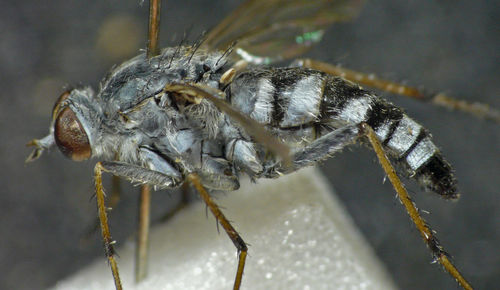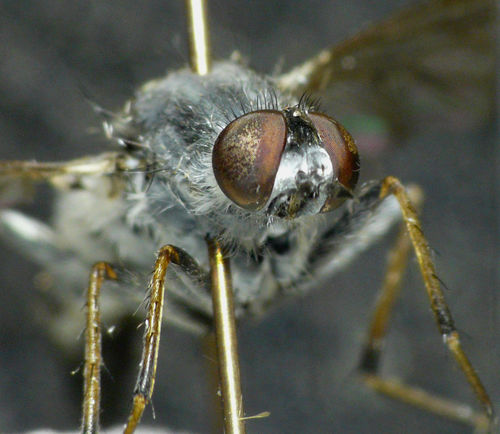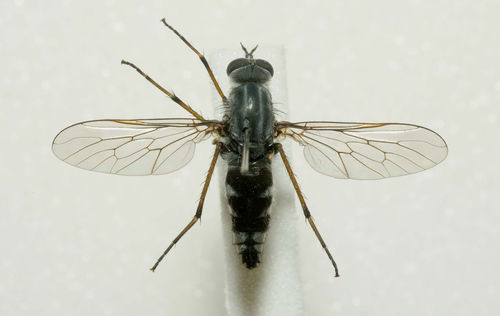Pandivirilia melaleuca (Leow) Forest Silver-stiletto fly (Diptera:Therevidae) in Southwest Worcestershire
Martin B Skirrow
Stiletto flies (Therevidae) owe their name to the tapering shape of their abdomen, which suggests the blade of a stiletto with the thorax as a handle. Thirteen species are recognised in Britain. The most widespread is Thereva nobilitata, but most of the others are uncommon. Pandivirilia melaleuca is a rare endangered RDB1 species. On 14th July 2013 I found a female of this species resting on a wall indoors in my converted cowshed dwelling on a farm in Berrow (VC37; SO777339). I stored it and did not come to examine the fly properly until January 2014. Only then did I realise that it was something unusual (01, 02, 03). Identity was confirmed by Martin Harvey from photographs.
The photographs show:
01. Dorsal View of pinned specimen of female Pandivirilia melaleuca Forest Silver-stiletto. Wing length 8mm.
02. Lateral view of Pandivirilia melaleuca showing extensive silvery markings. Males are even more silvery.
03. Frontal view of Pandivirilia melaleuca showing the silvery face.
04. Pandivirilia melaleuca female caught by Kevin McGee near Drakes Broughton in 2009.
Larvae of this species are believed to prey on saproxylic beetle larvae found in rotting wood in old hollow trees. In Keith Alexander’s checklist of invertebrates in decaying timber in Britain and Ireland the entry for Pandivirilia melaleuca runs as follows: “Larvae in very dry powdery red-rotten heartwood of oak and in decaying heartwood of ash, often devoid of other living macro-organisms; wide scatter of reports across southern Britain (although confirmation through rearing only from Windsor), but always ancient wood pastures.” (Alexander, 2002). In Britain, until 2006, it had been found regularly only in Windsor Forest and Great Park, but in that year, Keith Alexander successfully reared a larva of P. pandivirilia in wood mould from the base of a hollow live pear tree in Churcham, West Gloucestershire (SO757172) (Alexander, 2007). The fungus responsible for the red-rot in the Churcham pear tree was Laetiporus sulphureus. Then in 2009 Kevin McGee caught an adult female fly near the base of an oak stump at the Mill Meadow/Mill Rough complex, Drakes Broughton, in Worcestershire (SO919483) (McGee, 2009; 2010). McGee’s photograph of his specimen shows the close similarity to the Berrow fly (04).
Churcham is only 16 kilometres south of the Berrow farm, which has two old orchards with hollow trees, mostly apple and many blown down (though left undisturbed). There are no hollow oaks on the farm, but there is a large ancient hollow pear tree within 100 metres of the building where the fly was found and a hollow ash within 200 metres. Closer to the building was a huge heap of cut timber, some of which had been lying for at least 10 years and some of it well rotted. During the coming season a search is planned to look for saproxylic invertebrates in these hollow trees and hopefully find where the fly is breeding.
Alexander draws attention to the unusually rich fauna of saproxylic beetles in West Gloucestershire and of the existence of old orchards, effectively wood pastures, of the ancient forest country which ran between the Royal Forest of Dean and Malvern Chase (Alexander 2007). The need for preservation of what is left of these old orchards is obvious and pressing,
Acknowledgements
I am indebted to Martin Harvey for confirming the identity of the fly and to Kevin McGee for permission to reproduce his photograph of the fly.
References:
Alexander, K. N. A. 2002. The invertebrates of living and decaying timber in Britain & Ireland: a provisional annotated checklist. English Nature Research Report 467. English Nature Peterborough.
Alexander, K. N. A. 2007. Pandivirilia melaleuca (Loew) (Diptera, Therividae) confirmed as a Gloucestershire species. Dipterists Digest 14, 87-89.
McGee, K. 2009. An account of uncommon insects that I have recorded at the Mill Meadow/Mill Rough complex since 1996. Worcestershire Record No.27: 7-12.
McGee. K.A. 2010. The discovery of Pandivirilia melaleuca (Diptera: Therevidae) in Worcestershire. British Journal of Entomology and Natural History. 23.1: 56.
Images
01 Pandivirilia melaleuca female 14.7.13 dorsal Martin Skirrow
02 Pandivirilia melaleuca female 14.7.13 lateral Martin Skirrow.
03 Pandivirilia melaleuca female 14.7.13 frontal Martin Skirrow
04 Pandivirilia melaleuca 2009 Kevin McGee



